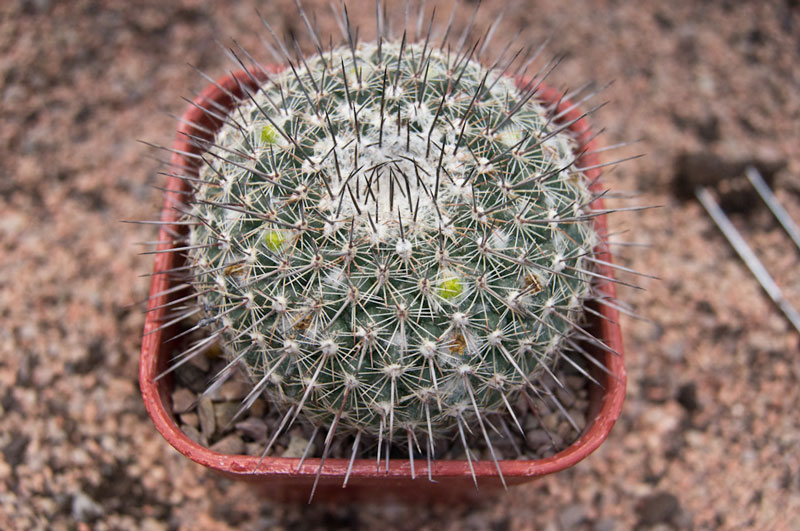
Mammillaria of the Month
(click here for previous Mamms of the Month)
Mammillaria sinforosensis ( or lindsayi?)

Photo: Plant in Cultivation: M. sinforosensis Copyright: Chris Davies 2011

Photo: Plant in Cultivation: M. sinforosensis v.cobrensis Copyright: Chris Davies 2011
|
By way of contrast to last month's Mammillaria lindsayi, here is a plant that for many years also was called Mammillaria lindsayi. The first plant was acquired as Mammillaria lindsayi a number of years ago from Holly Gate, and has grown into the nicely spined, yellow flowered plant shown above in bud. There are also red flowered forms of this plant, known variously as Mammillaria lindsayi v. cobrensis, Mammillaria cobrensis, or more recently as Mammillaria sinforosensis v. cobrensis. A plant in bud of this form is shown above as well, grown from seed in 1989 from BCSS seed. The history of the naming of this species is somewhat confused, but goes back to the original discovery of Mammillaria lindsayi and sent back to the US for later identification and naming, as referenced in Craig's monograpgh. It remained undiscovered again for a long time, meanwhile a somewaht similar plant was discovered, and believed to be Mammillaria lindsayi. It was not until a serious series of investigations by Hils, the Schumachers and Plein and Rogozinski that some clarity started to emerge about the distribution of this plant and eventually its renaming. While taxonomists will argue over the relative merits of the variety of names that have been used, it certainly needs differentiation from the plant that we featured last month. As such, for now at least, we'll use its most recently published name, Mammillaria sinforosensis. Whether the red flowered form, cobrensis, and another slightly different and more tightly spined form, marionae, deserve subspecies or varietal recognition is still an open debate. Like many of the plants of the Mammillaria standleyi complex (!), it comes from the high mountains of the Sierra Madre Occidentale, in North West Mexico. The region of the Barranca de Cobre is its home, where it is found in various locations. In cultivation it proves to be a resilient plant, perhaps betraying its high altitude roots, needing good sun to bring it into flower readily, but quite tolerant of cold if totally dry.
|